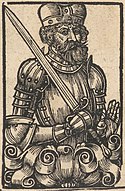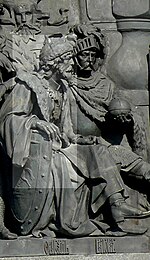| Algirdas | |
|---|---|
 Fragment from medal by Juozas Kalinauskas Fragment from medal by Juozas Kalinauskas | |
| Grand Duke of Lithuania | |
| Reign | 1345–1377 |
| Predecessor | Jaunutis |
| Successor | Jogaila |
| Duke of Zaslawye | |
| Reign | c. 1320–1345 |
| Successor | Jaunutis |
| Duke of Vitebsk | |
| Reign | 1318–1377 |
| Predecessor | Vasilko Briachislavich |
| Successor | Uliana Alexandrovna of Tver |
| Born | c. 1296 |
| Died | Late May 1377 possibly Maišiagala |
| Spouse | |
| Issue more... | |
| Dynasty | Gediminid |
| Father | Gediminas |
| Mother | Vida |
Algirdas (Belarusian: Альгерд, romanized: Alhierd; Ukrainian: Ольге́рд, О́льґерд, romanized: Olherd, Olgerd, Polish: Olgierd; c. 1296 – May 1377) was Grand Duke of Lithuania from 1345 to 1377. With the help of his brother Kęstutis (who defended the western border of the Duchy) he created an empire stretching from the present Baltic states to the Black Sea and to within 80 kilometres (50 miles) of Moscow.
Early life and rise to power
Algirdas was one of the seven sons of Grand Duke Gediminas. Before his death in 1341, Gediminas divided his domain, leaving his youngest son Jaunutis in possession of the capital, Vilnius. With the aid of his brother, Kęstutis, Algirdas drove out the incompetent Jaunutis and declared himself Grand Duke in 1345. He devoted the next thirty-two years to the development and expansion of the Grand Duchy of Lithuania.
After becoming the ruler of Lithuania, Algirdas was titled the King of Lithuania (Latin: rex Letwinorum) in the Livonian Chronicles instead of the terms knyaz (English: prince, duke) or velikiy knyaz (grand prince).
Two factors are thought to have contributed to this result: the political sagacity of Algirdas and the devotion of Kęstutis. The division of their dominions is illustrated by the fact that Algirdas appears almost exclusively in East Slavic sources, while Western chronicles primarily describe Kęstutis. Lithuania was surrounded by enemies. The Teutonic Order in the northwest and the Golden Horde in the southeast sought Lithuanian territory, while Poland to the west and the Moscow principality to the east were generally hostile competitors.
Expansion of Lithuania
— Algirdas' messengers statement to the Teutonic Order"The entire Rus' should belong to the Grand Duchy of Lithuania"

Algirdas held his own, also acquiring influence and territory at the expense of the Moscow principality and the Golden Horde and extending the borders of the Grand Duchy of Lithuania to the Black Sea. His principal efforts were directed toward securing the Slavic lands which were part of the former Kievan Rus'. Although Algirdas engineered the election of his son Andrius as Prince of Pskov and a powerful minority of Novgorod Republic citizens supported him against the Moscow principality, his rule in both commercial centres was (at best) precarious.
Algirdas occupied the important principalities of Smolensk and Bryansk. Although his relationship with the grand dukes of Moscow principality was generally friendly (demonstrated by his marriages to two Orthodox Russian princesses), he besieged Moscow in 1368 and 1370 during the Lithuanian–Muscovite War (1368–1372). An important feat by Algirdas was his victory over the Tatars in the Battle of Blue Waters at the Southern Bug in 1362, which resulted in the breakup of the Kipchaks and compelled the khan to establish his headquarters in the Crimea.
In a 1371 letter to Philotheus Kokkinos, the Ecumenical Patriarch of Constantinople, Algirdas titled himself as a Lithuanian King, demanded a separate metropolitan bishop (from Moscow) for Kyiv, Smolensk, Tver, Little Russia, Novosil, and Nizhny Novgorod, and denied Muscovite complaints that he attacked Moscow without a reason.
Religion and death


According to modern historians, "For Gediminas and Algirdas, retention of paganism provided a useful diplomatic tool and weapon ... that allowed them to use promises of conversion as a means of preserving their power and independence". Hermann von Wartberge and Jan Długosz described Algirdas as a pagan until his death in 1377. Contemporary Byzantine accounts support the Western sources; future Patriarch Nilus described Algirdas as a "fire-worshipping prince" and another patriarch, Philotheus, excommunicated all Ruthenian noblemen who helped the "impious" Algirdas. His pagan beliefs were also mentioned in 14th-century Byzantine historian Nicephorus Gregoras' accounts.
After his death, Algirdas was burned on a ceremonial pyre with 18 horses and many of his possessions in a forest near Maišiagala, probably in the Kukaveitis forest shrine located at 54°55′42″N 25°01′04″E / 54.92833°N 25.01778°E / 54.92833; 25.01778. His alleged burial site has undergone archaeological research since 2009. Algirdas' descendants include the Trubetzkoy, Czartoryski and Sanguszko families.
Although Algirdas was said to have ordered the death of Anthony, John, and Eustathius of Vilnius, who were later glorified as martyrs of the Russian Orthodox Church, the 16th-century Bychowiec Chronicle and 17th-century Hustynska Chronicle maintain that he converted to Orthodox Christianity some time before his marriage to Maria of Vitebsk in 1318. Several Orthodox churches were built in Vilnius during his reign, but later assertions about his baptism are uncorroborated by contemporary sources. Despite contemporary accounts and modern studies, however, some Russian historians (such as Batiushikov) claim that Algirdas was an Orthodox ruler. The Kiev Monastery of the Caves' commemorative book, underwritten by Algirdas' descendants, recorded his baptismal name as Demetrius during the 1460s. Algirdas married Uliana of Tver by 1350.
Following Wojciech Wijuk Kojałowicz and Macarius I, Volodymyr Antonovych writes that Algirdas took monastic vows several days before his death and was interred at the Cathedral of the Theotokos in Vilnius under the monastic name Alexius.
Issue
With Maria of Vitebsk:
- Andrei of Polotsk (1325 – 12 August 1399 in the Battle of the Vorskla River), Prince of Polotsk (1342–1387), Pskov (1342–1348)
- Demetrius I Starszy (1327 – 12 August 1399 in the Battle of the Vorskla River), Duke of Bryansk (1356–1379 and 1388–1399)
- Constantine (died before 30 October 1390), Prince of Chortoryisk. According to J. Tęgowski, he may be son of Karijotas.
- Vladimir Olgerdovich (died after October 1398), Grand Prince of Kiev (1362–1394), Kapyl, Slutsk. Ancestor of Olelkovich and Belsky families.
- Fiodor (Theodore; died in 1399), Prince of Rylsk (1370–1399), Ratnie (1387–1394), Bryansk (1393)
- Fiedora, wife of Sviatoslav of Karachev
- Agrypina (baptized Mary; died in 1393), wife of Boris of Suzdal
With Uliana of Tver:
- Jogaila (baptized Władysław; c. 1351 – 1 June 1434), Grand Duke of Lithuania (1377–1381, 1382–1392), King of Poland (1386–1434)
- Skirgaila (baptized Ivan; c. 1354 – 11 January 1397 in Kiev), Duke of Trakai (1382–1395), Kiev (1395–1397), regent of Lithuania
- Kaributas (baptized Dmitry; after 1350 – after 1404), Prince of Novhorod-Siverskyi (1386–1392/93)
- Lengvenis (baptised Simon; died after 19 June 1431), Prince of Mstislavl, regent of Novgorod Republic
- Karigaila (baptized Casimir; after 1350–1390), Prince of Mstislavl
- Vygantas (baptized Alexander; after 1350 – 28 June 1392), Prince of Kernavė
- Švitrigaila (baptized Bolesław; c. 1370 – 10 February 1452 in Lutsk), Grand Duke of Lithuania (1430–1432), Prince of Volhynia (1437–1452)
- Kenna (baptized Joan; c. 1350 – 27 April 1368), wife of Casimir IV, Duke of Pomerania
- Helen (after 1350 – 15 September 1438), wife of Vladimir the Bold
- Maria (born after 1350), wife of Vaidila and David of Gorodets
- Wilheida (baptized Catherine; after 1350 – after 4 April 1422), wife of John II, Duke of Mecklenburg-Stargard
- Alexandra (after 1350 – 19 June 1434), wife of Siemowit IV, Duke of Masovia
- Jadwiga (after 1350 – after 1407), wife of Jan III of Oświęcim
Through his son Vladimir, Algirdas is the fifth great-grandfather of Elizabeth Báthory.
Assessment

Algirdas balanced himself between Moscow principality and Poland, spoke Lithuanian and Ruthenian (among other languages) and followed the majority of his pagan and Orthodox subjects rather than to alienate them by promoting Roman Catholicism. His son Jogaila ascended the Polish throne, converted to Roman Catholicism and founded the dynasty which ruled Lithuania and Poland for nearly 200 years.
Algirdas (Belarusian: Альгерд, Alhierd) is also widely honoured in Belarus as a unifier of all Belarusian lands within one state, a successful military commander and ruler of medieval Belarus. A monument to him has been erected in Vitsebsk in 2014, as part of the celebration of the city's 1040th anniversary. Algirdas was Duke of Vitebsk for over 20 years before becoming Grand Duke of Lithuania.
In December 2022, the National Bank of the Republic of Belarus issued a commemorative coin dedicated to the Battle of Blue Waters with a portrait of Algirdas.
Popular culture
Algirdas features in the 2021 video game Age of Empires II: Definitive Edition in the Dawn of the Dukes campaign, detailing the exploits of himself and his brother Kęstutis.
See also
References
- "Algirdas | grand duke of Lithuania". Encyclopædia Britannica. Retrieved 25 June 2021.
- "Algirdas". vle.lt. Retrieved 20 November 2019.
- ^ Bain, Robert Nisbet (1911). "Olgierd" . Encyclopædia Britannica. Vol. 20 (11th ed.). p. 80.
- Ūsienė, Auksė. Lietuvos karaliai arba Lietuvos valstybės statusas XIII–XIV a. (PDF) (in Lithuanian). Ministry of National Defence of Lithuania. p. 7. Retrieved 7 March 2022.
- Baranauskas, Tomas. "Medieval Lithuania – Sources 1283–1386". viduramziu.istorija.net (in English and Latin). Archived from the original on 8 April 2022. Retrieved 7 March 2022.
- "Didžioji Lietuva rusų istoriko akimis". ve.lt (in Lithuanian). 2 July 2016. Retrieved 22 September 2019.
- "D.L.K. ALGIRDO ŽYGIAI MASKVON 1368 – 1372 M". partizanai.org (in Lithuanian). Retrieved 24 April 2020.
- Kuolys, Darius. "Algirdo laiškas". Šaltiniai.info (in Lithuanian). Retrieved 1 May 2023.
- Muldoon, James. Varieties of Religious Conversion in the Middle Ages. University Press of Florida, 1997. Page 140.
- F. Miklosich, J. Mūller. Acta Patriarchatus Constantinopolitan. Vienna, 1862, Vol. 2, p.12
- F. Miklosich, J. Mūller. Acta Patriarchatus Constantinopolitan. Vienna, 1862, Vol. 1, pp. 523–524
- I. Bekker. Nicephori Gregorae Historiae Byzantinae. Bonn, 1829, Vol. 3 pp. 517–520
- "He was cremated with the best horses, clothes, resplendent in gold and girdled with a gilded silver belt and was covered with a gown woven of beads and gems", Marija Gimbutas has observed Archived 9 June 2007 at the Wayback Machine.
- Vaitkevičius, Vykintas. "Kukaveičio šventvietės mįslės". satenai.lt. Archived from the original on 26 June 2008. Retrieved 24 December 2022.
- Lokalizavo kunigaikščio Algirdo palaikų kremavimo vietą Archived 6 September 2008 at the Wayback Machine. retrieved on 22 May 2009
- Contributed by Antoni Prochaska, Jan Ochmanski, Gotthold Rhode, Marija Gimbutas, Edvardas Gudavičius etc.
- Mažeika, Rasa (1987). "Was Grand Prince Algirdas a Greek Orthodox Christian?". Lituanus. 33 (4). Archived from the original on 7 June 2011. Retrieved 6 September 2007.
- ^ Nowakowska 2019, p. x.
- Tęgowski J. Który Konstanty – Olgierdowic czy Koriatowic – był przodkiem kniaziów Czartoryskich? // Europa Orientalis. – Toruń, 1996. – S. 53-59.
- Князь Альгерд нарэшце вярнуўся ў Віцебск [Duke Alhierd Finally Returns to Viciebsk]
- У Менску адкрылася выстава “Князь Альгерд у выяўленчым мастацтве” [Exhibition "Duke Alhierd in Visual Arts" Opened in Minsk]
- У Віцебску ўсталявалі помнік князю Альгерду. Фотарэпартаж [Monument to Duke Alhierd installed in Viciebsk. Photos]
- "Нацыянальны банк выпусціў у абарачэнне памятныя манеты "Бітва на Сініх Водах"". budzma.me. 29 December 2022. Retrieved 29 December 2022.
- Beckhelling, Imogen (11 August 2021). "Age of Empires 2: Definitive Edition adds new civilisations – the Poles and the Bohemians". RPS. Retrieved 16 May 2022.
Sources
- Nowakowska, Natalia, ed. (2019). Remembering the Jagiellonians. Routledge. ISBN 978-1-138-56239-4.
| Algirdas Gediminid dynastyBorn: c. 1296 Died: May 1377 | ||
| Preceded byJaunutis | Grand Prince of Lithuania along with Kęstutis 1345–1377 |
Succeeded byJogaila |
| Preceded byYaroslav | Prince of Vitebsk 1345–1377 |
Succeeded byUliana |
| Monarchs of Lithuania | |||||||||||
|---|---|---|---|---|---|---|---|---|---|---|---|
| Kingdom of Lithuania |
| ||||||||||
| Grand Duchy of Lithuania |
| ||||||||||
| Polish–Lithuanian Commonwealth |
| ||||||||||
| Kingdom of Lithuania |
| ||||||||||
| Titular rulers are in italics. | |||||||||||